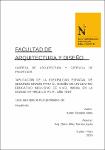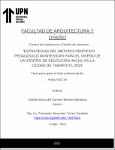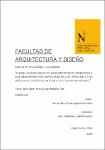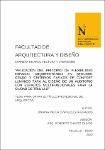| dc.contributor.advisor | Torres Loyola, Elmer Miky | |
| dc.contributor.author | Paredes Mora, Karen | |
| dc.date.accessioned | 2021-02-05T14:04:42Z | |
| dc.date.available | 2021-02-05T14:04:42Z | |
| dc.date.issued | 2020-08-10 | |
| dc.identifier.citation | Paredes, K. (2020). Aplicación de la flexibilidad espacial de segundo grado para el diseño de un centro educativo inclusivo de nivel inicial en la ciudad de Trujillo en el año 2018 (Tesis de licenciatura). Repositorio de la Universidad Privada del Norte. Recuperado de https://hdl.handle.net/11537/24927 | es_PE |
| dc.identifier.other | 720.49 PARE 2020 | es_PE |
| dc.identifier.uri | https://hdl.handle.net/11537/24927 | |
| dc.description.abstract | En La Libertad existen 71 mil 839 personas con discapacidad de los cuales, según los
datos del INEI, hacia el 2015 el 39,6% de la población discapacitada infantil de entre 3-5
años no tuvo acceso a educación básica. Los niños con habilidades diferente desean que
se les incluya en la sociedad; por ello en la Conferencia Mundial sobre Necesidades
Educativas Especiales se concluye que se necesitan escuelas ordinarias con orientación
integradora e inclusiva para combatir las actitudes discriminatorias y enseñar a los niños
(con disparidad y sin ella) a convivir entre ellos. En el Perú, y en Trujillo, se viene
impulsando la Educación inclusiva, se han habilitado Escuelas Especiales e Inclusivas; sin
embargo, estas no cuentan con la infraestructura pertinente y necesaria para niños con
discapacidad; por ello se plantea un Centro Educativo Inclusivo de nivel inicial con
principios de Flexibilidad espacial de segundo grado, de modo que las aulas se adapten a
la diversidad de niños y contribuya a su aprendizaje y socialización.
El proyecto se concibe bajo los principios de flexibilidad espacial de segundo grado, cuya
premisa principal, es permitir que el espacio educativo sea libre y sin límites, por ello las
aulas pueden ampliarse, permitiendo que las creatividades en su uso sean máximos. Así
mismo, se generan módulos repetitivos los cuales están configurados alrededor de un patio
para generar una relación interior- exterior en el aula.
Los principios de flexibilidad espacial de segundo grado aplicados en el diseño de un centro
educativo inclusivo de nivel inicial, se validan mediante el uso de sistemas movibles,
modulación de forma central y continuidad espacial, los cuales permiten manipular el
espacio adaptándolo a las actividades que cada vez son más cambiantes; en este caso los
más utilizados son los paneles plegables, corredizos y paneles desmontables, estos
permiten extender el espacio hacia los jardines interiores generados. | es_PE |
| dc.description.abstract | In La Libertad there are 71 thousand 839 people with disabilities of which, according to the
INEI data, by 2015 39.6% of the disabled child population of 3-5 years did not have access
to basic education. Children with different abilities want to be required in society; Therefore,
at the World Conference on Special Educational Needs, it is concluded that ordinary
schools with an inclusive and inclusive orientation are needed to combat discriminatory
attitudes and teach children (with disparity and without it) to live together. In Peru, and in
Trujillo, inclusive education is being promoted, Special and Inclusive Schools have been
enabled; however, they do not have the necessary and necessary infrastructure for children
with disabilities; for this reason, an Inclusive Educational Center of initial level with principles
of spatial Flexibility of second degree is proposed, so that the classrooms adapt to the
diversity of children and contribute to their learning and socialization.
The project is conceived under the principles of spatial flexibility of the second degree,
whose main premise is to allow the educational space to be free and without limits, so the
classrooms can be expanded, allow creatives in their use to be maximum. Likewise,
repetitive modules are generated which are configured around a patio to generate an
indoor-outdoor relationship in the classroom.
The principles of spatial flexibility of the second degree applied in the design of an inclusive
educational center of initial level, are validated through the use of mobile systems, centrally
modulated and spatial continuity, which allow manipulating the space adapted to the
activities that each they are ever more changing; In this case, the most used are the folding,
sliding and removable panels, these allow to extend the space towards the generated
interior gardens. | es_PE |
| dc.description.uri | Tesis | es_PE |
| dc.format | application/pdf | es_PE |
| dc.format | application/msword | es_PE |
| dc.language.iso | spa | es_PE |
| dc.publisher | Universidad Privada del Norte | es_PE |
| dc.rights | info:eu-repo/semantics/openAccess | es_PE |
| dc.rights.uri | https://creativecommons.org/licenses/by-nc-sa/4.0/ | * |
| dc.source | Universidad Privada del Norte | es_PE |
| dc.source | Repositorio Institucional - UPN | es_PE |
| dc.subject | Espacio en arquitectura | es_PE |
| dc.subject | Edificios educativos | es_PE |
| dc.subject | Educación inicial | es_PE |
| dc.title | Aplicación de la flexibilidad espacial de segundo grado para el diseño de un centro educativo inclusivo de nivel inicial en la ciudad de Trujillo en el año 2018 | es_PE |
| dc.type | info:eu-repo/semantics/bachelorThesis | es_PE |
| thesis.degree.grantor | Universidad Privada del Norte. Facultad de Arquitectura y Diseño | es_PE |
| thesis.degree.level | Título Profesional | es_PE |
| thesis.degree.discipline | Arquitectura y Gerencia de Proyectos | es_PE |
| thesis.degree.name | Arquitecto | es_PE |
| dc.publisher.country | PE | es_PE |
| dc.subject.ocde | https://purl.org/pe-repo/ocde/ford#6.04.08 | es_PE |
| thesis.degree.program | Pregrado | es_PE |
| dc.description.sede | Trujillo El Molino | es_PE |
| renati.advisor.dni | 43436181 | |
| renati.advisor.orcid | https://orcid.org/0000-0001-8309-0547 | es_PE |
| renati.author.dni | 71688960 | |
| renati.discipline | 731116 | es_PE |
| renati.juror | Bocanegra Galván, Hugo Gualberto | |
| renati.juror | Chávez Olivos, Roberto Octavio | |
| renati.juror | Torres Zavaleta, Fernando Alexander | |
| renati.level | https://purl.org/pe-repo/renati/level#tituloProfesional | es_PE |
| renati.type | https://purl.org/pe-repo/renati/type#tesis | es_PE |








